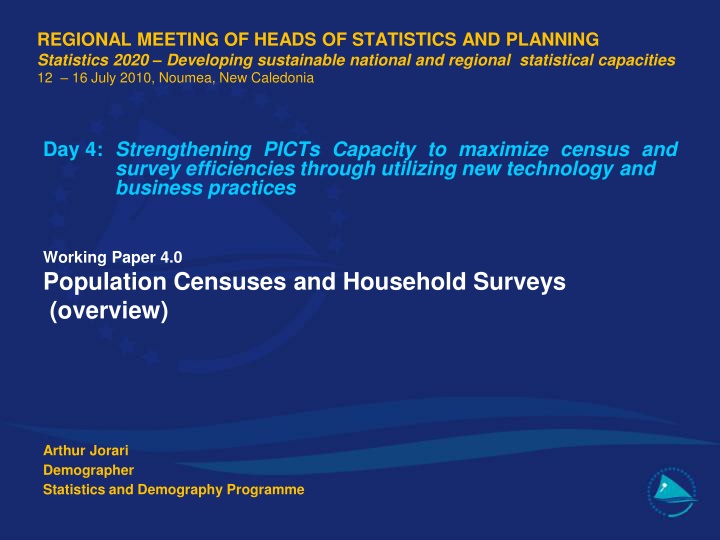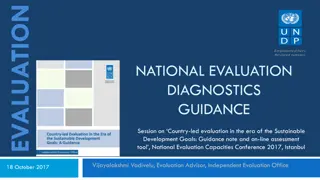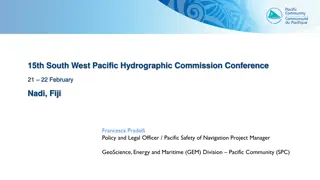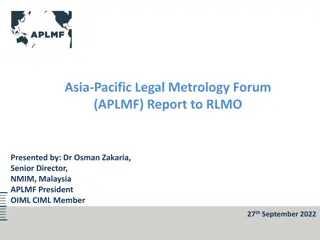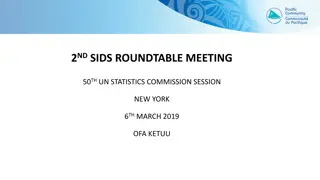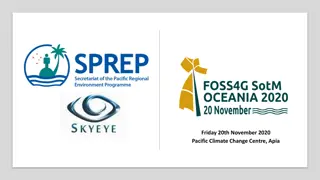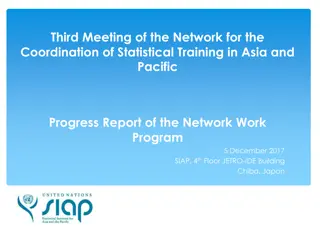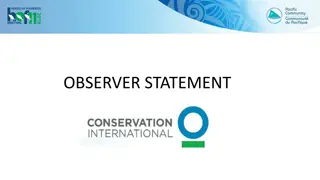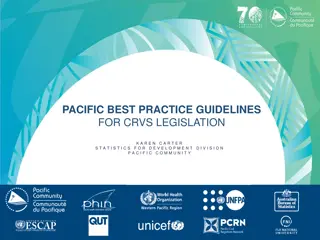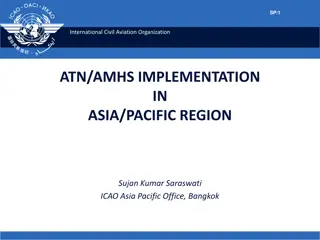Developing Sustainable Statistical Capacities in the Pacific Region
This presentation focuses on the complexities and advancements in census and survey taking in the Pacific region, highlighting the importance of proper planning, resource mobilization, and training to ensure quality results. It discusses the evolution of census tools and technologies, emphasizing the need for skilled human resources and budget allocation for modern census operations.
Download Presentation

Please find below an Image/Link to download the presentation.
The content on the website is provided AS IS for your information and personal use only. It may not be sold, licensed, or shared on other websites without obtaining consent from the author.If you encounter any issues during the download, it is possible that the publisher has removed the file from their server.
You are allowed to download the files provided on this website for personal or commercial use, subject to the condition that they are used lawfully. All files are the property of their respective owners.
The content on the website is provided AS IS for your information and personal use only. It may not be sold, licensed, or shared on other websites without obtaining consent from the author.
E N D
Presentation Transcript
REGIONAL MEETING OF HEADS OF STATISTICS AND PLANNING Statistics 2020 Developing sustainable national and regional statistical capacities 12 16 July 2010, Noumea, New Caledonia Day 4: Strengthening PICTs Capacity to maximize census and survey efficiencies through utilizing new technology and business practices Working Paper 4.0 Population Censuses and Household Surveys (overview) Arthur Jorari Demographer Statistics and Demography Programme
Purpose of presentation To provide a brief overview of the complexities of census and survey taking in the Pacific in some of the key activity phases. To highlight the need for proper planning, activity scheduling, resource mobilization, training, field management, project management in general and project coordination to ensure quality coverage and timely production of results.
Presentation outline 1. Background 2. Use of census/survey outputs 3. Key census/survey activities 4. Discussion points
Background to presentation In the years since the first round of Pacific censuses, census taking has grown to a sophisticated tool for basic population and socioeconomic data of the population (in the absence or incomplete civil or vital registration systems as well as weak overall administrative records and databases); For instance the questionnaires used in the 2010 round of censuses are more complex and cover many more subject- matter areas then those used in the years prior to 1960, or 1960 and 1970 round of censuses; In addition, compared to earlier round of censuses, experience with new technologies introduced in the 2010 round of censuses add another dimension of complexity in terms of cost and skills required for quality census taking.
Background to presentation (continued) These resources and technical support requirements; complexities also contribute towards increased o For example, modern census and survey operations require considerable budgets and a more skilled human resources base to support new technologies, including new computer software and equipment compared to resource requirement of the earlier round of censuses; Proper training and related developments are necessary and paramount to ensure human resources are highly skilled for modern census taking.
Background to presentation (continued) As already highlighted in Working Paper 1.1: o to successfully conduct a national census or household survey, good planning is essential, requiring first and foremost a good understanding of previous censuses and household surveys undertaken and of lessons learned; o this then paves the way for good project planning, containing a detailed activity plan with both realistic timelines and delineation of responsibilities for various census and survey activities, including internal and external resources mobilization.
Use of census/survey outputs In the absence of complete administrative recording systems in many PICTs, population censuses and household surveys serve as the main data sources for: o regular government development planning and monitoring for national sustainable development policies and plans, sector policies/plans, and o indicators for global reports like national MDG or CEDAW Reports. In addition emerging development issues like food security, impact of climate change, culture and development, and contribution of traditional economies to population wellbeing draw on population censuses and household surveys as main data sources for analysis and understanding of existing situations.
Use of census/survey outputs (continued) Given the high cost and increasing complexities of census/survey data collection, as well as the many potential uses of these data, it is important to ensure that census and survey plans allow: i. ii. sufficient time for extensive user consultations; and address the production dissemination in general exposure to and utilization of such a rich data source. of to outputs facilitate and maximum data
Key census and survey activities Census/Survey Planning Reviewing our involvement in all censuses and surveys undertaken since 2007, it has become clear that good planning is not just about covering all activities in a sequential logic, but also about allocating: i. ii. realistic timelines and managerial responsibilities; and effective field operations management. While including designated task managers, timelines were not always realistic, and field operation management, particularly the supervision of enumerators lagged behind best practice expectations in many places. all countries had good census and survey plans in place These two features we believe, have the single biggest impact on data quality and accounting for a good census and survey outcome.
Key census and survey activities (continued) Household listing and mapping development To undertake a good listing exercise and develop an accurate cartographic basis of dwellings can take up to anywhere between 3 12 months, depending of course on population size/distribution and numbers of listing/cartography teams involved. While all PICTS have taken on such activities in recent years, there are concerns with quality in some places, with insufficient time allocated to these tasks, combined with rushed training of temporary staff and insufficient field supervision topping the list of activities that need special attention. Detailed discussion will be in the next Session 4.1
Key census and survey activities (continued) Questionnaire design and content The use of word/excel for questionnaire design is gradually ending as new software are becoming available for such purpose - for example, Adobe InDesign software (detailed discussion in Session 4.3). Deciding on topics and questions to include in censuses and household surveys is an interactive process involving NSOs and their key stakeholders. Both population and housing questions continue to change from census to census as user needs change or expand (detailed discussion in Session 4.2). As this has significant implications on form design and costs, not all new proposals can usually be considered. While survey forms of major household surveys undertaken since 2007 have remained more stable over time, there have been some additions in the form of optional modules developed on health and labor market activities, following specific interest and requests by countries to do so.
Key census and survey activities (continued) Census and survey training Extensively covered on Day 1 (Working Paper 1.3), thus Session 4.4 will make reference to a specific training component recently introduced in the main training of census field supervisors and enumerators, that incorporates lessons learned from the Pilot test; Census trainers and pilot census data analysts collaborated in communicating the results and highlight the implications and impact of erroneous data collection and recording, bad field supervision, and the importance of maintaining strict quality control processes in the main census training of trainers, with the objective of improving data quality and field management practices.
Key census and survey activities (continued) Census field work and quality control Despite good intentions in census/survey training, field operational management and quality control procedures are still not universally well managed. Recent experience show that field supervision and editing was not of consistent and acceptable quality in most countries: if done properly, no form should ever reach census or survey headquarters with missing or incomplete information. Census project managers have not consistently adhered to best practice census and survey documentation; the same applies to supervisors and area managers, who are not consistently producing operational reports that document field operations and procedures, outlining what worked and what did not, and spelling out lessons learned and modifications made.
Key census and survey activities (continued) The use of technology A major introduction in the Pacific in the 2010 census round was that census takers took advantage of available hardware and software and advances in information technology and systems assisting with household listing and questionnaire processing (Session 4.3) and data dissemination (Session 5 tomorrow). mapping (Session 4.1),
Key census and survey activities (continued) Census and Survey evaluation This phase of a census/survey operation does not take place in many PICTs. Except for demographic approach to census evaluation with various indices, the use of post enumeration survey for census evaluation, for example, has not been undertaken anywhere in the Pacific in recent years, dating back to the 2000 PNG census. While some countries had planned to undertake a PES as highlighted in their census activity plan, they did not implement this due to time and budgetary constraints. Therefore census coverage rates and related indicators of completeness are not computed, and made available to data users. While recent developments in census cartography allow for some indirect assessment of coverage as will be demonstrated in another presentation later on, it is important for user confidence that Pacific census takers consider including post enumeration surveys as integral parts of census operations
Discussion Points Conference is invite to comment on: i. The need for proper census project planning, and ways of improving project implementation and management; ii. The need for census documentation at every phase, to provide the institutional memory for future censuses and surveys; iii. The inclusion of a pilot census as an integral part of PICT census operations, to serve as a complete dress rehearsal of census operations and procedures, to allow for a comprehensive review and assessment of systems and procedures, thus laying the foundation for improving the main census operations; and iv. The importance of proper census evaluations that include post enumeration surveys as an integral part of census operations to ensure user confidence in census data.
